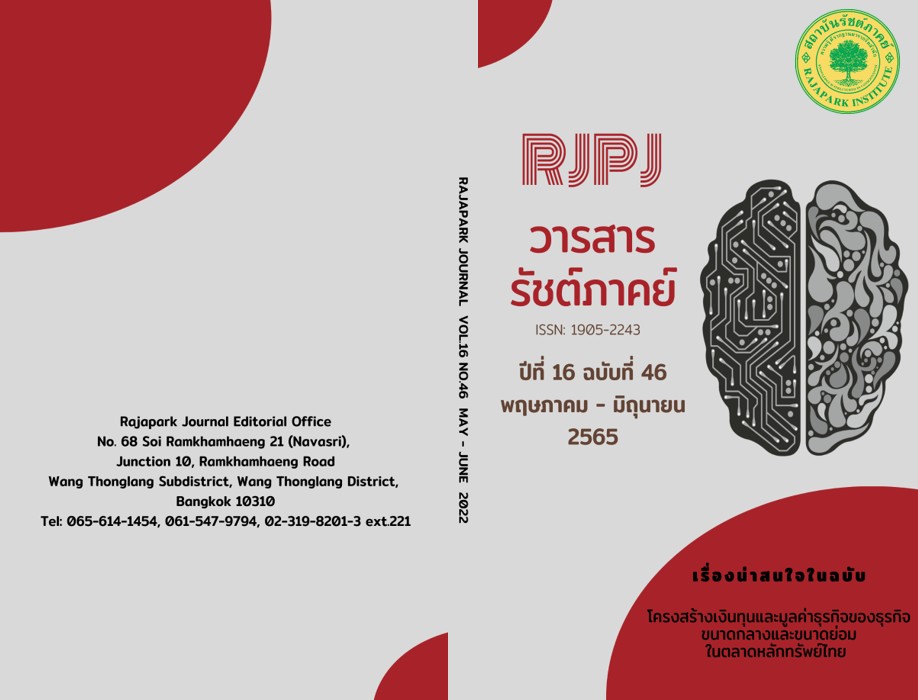Enhancement of Enterprises with Marketing Strategies for Safe Food Production
Main Article Content
Abstract
The purposes of this research were to develop marketing strategies for U-Place Hotel restaurant and Basin restaurant to be a safe food restaurants and to implement marketing strategies for safe food. Market research before developing strategies collected data from 400 consumers who used to purchase cooked food. The sample was selected based on firstly, the quota sampling method for each restaurant and secondly, convenience sampling. The data analysis uses descriptive and T-test. The analysis was also carried out for business environment analysis by using PEST Analysis and SWOT Analysis. Strategy development uses TOWS Matrix. The research results illustrated that product is the most important factor for cooked food purchasing decisions. Marketing strategy development and implementation of both restaurants are as follows food sanitation training, uniform standards-setting for employees, accreditation of Clean Food Good Taste certificate, utilizing safe vegetables for cooking, outstanding packaging design, online marketing using Facebook and Line, and offers food delivery services. In conclusion, this research developed effective marketing strategies which enhance restaurants’ competitive advantages.
Article Details

This work is licensed under a Creative Commons Attribution-NonCommercial-NoDerivatives 4.0 International License.
Views and opinions appearing in the Journal it is the responsibility of the author of the article, and does not constitute the view and responsibility of the editorial team.
References
Al-Samirae, Z., S. Alshibly, M., & Alghizzawi, M. (2020). Excellence in Drawing Up Marketing Mix Strategies for Small and Medium Enterprises (SMEs) and Their Impact on the Marketing Performance. Business, Management and Economics Research, 6(3), 30-36.
Bltbangkok.com. (2018, August 17). Healthy Trend Has Been Very Popular. Bltbangkok. https://www.bltbangkok.com/bangkok-update/4405/
Brodie, R. J., Ilic, A., Juric, B., & Hollebeek, L. (2013). Consumer Engagement in a Virtual Brand Community: An Exploratory Analysis. Journal of Business Research, 66(8), 105–114.
Dangkhaw, N., Suksri, C., & Ophang, A. (2018). Food Safety in Hospitality Industry. Dusit Thani College Journal, 12(2), 417-433.
Department of Disease Control. (2019). Epidemiological Surveillance Report 2019. Department of Disease Control. https://ddc.moph.go.th/uploads/publish/1129820210620030431.pdf
Department of Health. (2021, March). Food Sanitary Standards Guide: Clean Food Good Taste. https://foodsan.anamai.moph.go.th/web-upload/13x34cba8a8c311038000343e8ab441d5ff/m_magazine
/32630/2360/file_download/b8e21d7e61ad0de2fb053768954b3fec.pdf
Eggers, F., Kraus, S., Hughes, M., Laraway, S., & Snycerski, S. (2013). Implications of Customer and Entrepreneurial Orientations for SME Growth. Management Decision, 51(3), 524-546.
Food Safety Research and Risk Assessment Center. (2012). Food Hazard. http://www.nfi.or.th/foodsafety/index.php.
Glaharn, S., & Saiyakul, K. (2021). Component of Entrepreneurial Characteristics Views of Generation Y. Panyapiwat Journal, 12(2), 124-134.
Hfocus.org. (2019). Year 2018 Universal Coverage Scheme Cover Cancer Patient Over 234,000 People. https://www.hfocus.org/content/2019/03/17001.
Hacioglu, G., & Gök, O. (2013). Marketing Performance Measurement: Marketing Metrics in Turkish Firms. Journal of Business Economics and Management, 14(1), 413-432.
Khumhome, B., Juntarukka, S., & Zheng, C. J. (2020). Marketing Strategy for Food Safety Market in Ubonratchathani Province[Research Report, Ubonratchathani University].
Kotler, P., Keller, K. L., Ang, S. H., Leong, S. M., & Tan, C. T. (2003). Marketing Management an Asian Perspective (3rd ed). Pearson Education.
Lakphanphakdee, C. (2017). Factor Affecting Purchase Decision for Food Ordered Online in The Bangkok Metropolitan Area[Master’s Thesis, Thammasat University].
Limpasirisuwan, N. (2016). A Structural Equation Model for Enhancing Online Brand Community Loyalty[Doctoral Dissertation, Suranaree University of Technology].
Makasiranon, W. (2006). Writing a Marketing Plan (7th ed). Expernet.
Mendes, L., & Lourenço, L. (2014). Factors that Hinder Quality Improvement Programs’ Implementation in SME. Journal of Small Business and Enterprise Development, 21(4), 690–715.
Mongray, J. (2006). Strategic Marketing. A Literature Review on Definitions, Concepts and Boundaries. https://mpra.ub.uni-muenchen.de/41840/1/MPRA_paper_41840.pdf
NoonNum Digital Marketing Buddy. (2020). How Often to Post on Social Media. https://www.noonnum.com/post/how-often-should-i-post-on-social-media-noonnum-podcast-ep-148
Office of the President of Ubon Ratchathani University. (2017). Five-year Strategic Plan of Ubon Ratchathani University 2017-2021. https://www.ubu.ac.th/web/files_up/03f2017080210191586.pdf
Office of the Permanent Secretary of Ministry of Public Health. (2020). Safe Food in the New Normal Era. http://foodsafety.moph.go.th/_WEBADMIN2/uploads/n_file/2x85p55qnfgg048808.pdf
Post Today. (2018). Student Risk! The Research Show Insecticide Contamination in Food. Post Today. https://www.posttoday.com/social/general/573610
Sriphong, C. (2006). The Managerial Behaviors of Executives in Business Sector in the Three Southernmost Provinces. Journal of Yala Rajabhat University, 1(2), 102-111.
Sudari, S., Tarofder, A., Khatibi, A., & Tham, J. (2019). Measuring the Critical Effect of Marketing Mix on Customer Loyalty through Customer Satisfaction in Food and Beverage Products. Management Science Letters, 9(9), 1385-1396.
Yanisa, P. (2018). Types of Restaurants with Characteristics of the Successful Restaurant Entrepreneurs in Phra Nakhon Si Ayutthaya Province. Veridian E-Journal, Silpakorn University (Humanities, Social Sciences and Art), 11(1), 303–321.


